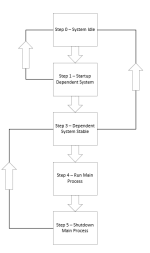Misc notes on SFC
Any SFC editor that I am familiar with will easily do what you want. Steps 1 and 3 need a divergence after the step. One transition on each divergence will go to a jump to a specific step.
Allen Bradley's Ladder editor is excellent. Their SFC editor is extremely awkward. Schneiders SFC editor is really good, their ladder editor is almost unusable. Either one can be used to do what you want to do in a very similar way.
SFC implementations seem to differ in the details of what they do on powerup, how to reset the SFC to the initial state, and so on. Try to minimize your use of brand-specific features.
IMHO the various step actions tend to be overly complex and frequently not needed. Most of the SFC that I do involves ladder code for preprocessing inputs, controlling outputs, and so on. Trying to do combinational logic (AND, OR, etc) in SFC is a real bad idea. Use each IEC language for what it is good at and don't try to force-fit something into the wrong language. Don't do loops and matrix operations in ladder - that's what ST is for.
You can't jump from any step to any other step as there are some rules. SFC analysis is a logical reduction process that is used to determine is an SFC topology is valid. You don't have to do it yourself as your compiler will throw an error if your topology is bad - but it is a good idea to understand invalid constructions if you are learning SFC. These include jumps into and out of simultaneous branches and other things.
The PLC class outline download at CorsairHMI.com includes an introductory discussion of SFC analysis starting around page 242. PM me for some free educational software that does it if you want to learn or teach it.
It takes experience to come up with clean SFC charts. If it looks messy - it probably is. Messy SFC may be an indication of improper layering of tasks.
SFC requires a lot of thought drawing pictures before writing code - but no more than well-written ladder. If seems that many people are too quick to hit the keyboard and start clicking and punching before they hit pen and paper. I frequently draw some sort of state diagrams before writing ladder. These diagrams sometimes translate very clearly to SFC.
Process upset conditions like emergency stops can be a challenge with SFC.
Corsair's first law of software stability is 'When a process is at a point where the status of an input is unimportant that input is ignored'. The classic example is the fill cycle on a washing machine followed by the wash cycle. The full switch is needed to advance from the fill to the wash state. Once the machine is in wash the full switch needs to be ignored. SFC frequently makes it much simpler to implement Corsair's first law. It's not as clear with ladder.
The class outline includes some of the theory for translating state transition diagrams to ladder logic using the flip-flop stuff that many of us learned in our digital electronics classes. Trying to be a PLC programmer without these things is like trying to be a concert pianist without first practicing the scales. Each trade involves paying dues in some way - ours is no exception.






